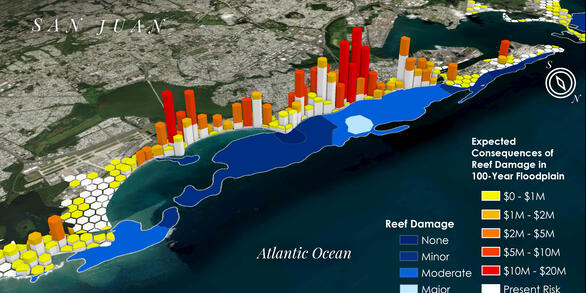Publications
Scientific reports, journal articles, and information products produced by USGS Pacific Coastal and Marine Science Center scientists.
Filter Total Items: 1380
Did the Aleutian Basin form by plate capture or backarc basin opening?
The origin of the Aleutian Basin is unresolved because its crust is deeply buried beneath sediments. It has been interpreted as forming in the Eocene when the Beringian convergent margin jumped seaward to south of the Aleutian arc, thereby capturing a large sector of Cretaceous Pacific crust. Alternatively, it may have formed by backarc spreading. We present new magnetic and seismic...
Authors
Robert J. Stern, David W. Scholl, Matthew A. Malkowski, Kylara M. Martin, Ginger Barth, Daniel Scheirer
Developing a probabilistic tsunami hazard assessment framework for Pacific sources: USGS Powell Center meeting summary
Multi-organizational principal investigators formed a U.S. Geological Survey (USGS) Powell Center Working Group (WG), Tsunami Source Standardization for Hazards Mitigation in the United States, to develop a comprehensive series of sources capable of generating tsunamis that could impact U.S. state and territory coastal areas using probabilistic tsunami hazard analysis (PTHA). PTHA...
Authors
Jason R. Patton, Stephanie L Ross, Marie C. Eble, Christodoulos Kyriakopoulos, Patrick J. Lynett, DmitriyJ. Nicolsky, Kenneth Ryan, Hong Kie Thio, Rick I. Wilson, Baoning Wu
Characterizing sedimentary organic carbon in a hydrothermal spreading center, the Escanaba Trough
Sediments in critical marine mineral environments are of wide importance due to their preservation of both marine minerals and organic carbon (OC) stocks. However, OC storage and cycling is often overlooked in mineral system studies. This work characterizes sedimentary OC within the Escanaba Trough, a hydrothermal sulfide system off the coast of northern California. By utilizing ROV...
Authors
Hope Lee Ianiri, Pamela Swarzenski, Amy Gartman, Nancy Prouty
Shoreline seasonality of California’s beaches
We report on remote sensing techniques developed to characterize seasonal shoreline cycles from satellite-derived shoreline measurements. These techniques are applied to 22-yr of shoreline measurements for over 777 km of beach along California's 1,700-km coast, for which the general understanding is that shorelines exhibit winter-narrow and summer-recovery seasonality. We find that...
Authors
Jonathan Warrick, Daniel D. Buscombe, Kilian Vos, Hannah Kenyon, Andrew C. Ritchie, Mitchell D. Harley, Catherine Nicole Janda, Jess L'Heureux, Sean Vitousek
Coral reef restoration can reduce coastal contamination and pollution hazards
Coral reef restoration can reduce the wave-driven flooding for coastal communities. However, this protection has yet to be assessed in terms of the reduced risk of flood-driven environmental contamination. Here we provide the first high-resolution valuation of the reduction of flood-related land-based environmental pollution provided by potential coral reef restoration. Along Florida’s...
Authors
Marina Rottmueller, Curt D. Storlazzi, Fabian Frick
Combining multisite tsunami and deformation modeling to constrain slip distributions for the 1700 C.E. Cascadia earthquake
A major earthquake ruptured the Cascadia subduction zone (CSZ) on 26 January 1700. Key paleoseismic evidence associated with this event include tsunami deposits, stratigraphic evidence of coastal coseismic subsidence, written Japanese records of a tsunami unaccompanied by earthquake shaking, and margin‐wide turbidites found offshore and in lacustrine environments. Despite this wealth of...
Authors
David Small, Diego Melgar, SeanPaul La Selle, Andrew J Meigs
Hybrid coral reef restoration can be a cost-effective nature-based solution to provide protection to vulnerable coastal populations
Coral reefs can mitigate flood damages by providing protection to tropical coastal communities whose populations are dense, growing fast, and have predominantly lower-middle income. This study provides the first fine-scale, regionally modeled valuations of how flood risk reductions associated with hybrid coral reef restoration could benefit people, property, and economic activity along...
Authors
Curt D. Storlazzi, Borja G. Reguero, Kristen A. Alkins, James B. Shope, Aaron Cole, Camila Gaido-Lassarre, T. Shay Viehman, Michael W. Beck
Post-fire sediment yield from a western Sierra Nevada watershed burned by the 2021 Caldor Fire
Watershed sediment yield commonly increases after wildfire, often causing negative impacts to downstream infrastructure and water resources. Post-fire erosion is important to understand and quantify because it is increasingly placing water supplies, habitat, communities, and infrastructure at risk as fire regimes intensify in a warming climate. However, measurements of post-fire sediment...
Authors
Amy East, Joshua B. Logan, Peter Dartnell, Helen Willemien Dow, Donald N. Lindsay, David B. Cavagnaro
Shoreline change of western Long Island, New York, from satellite-derived shorelines
Shoreline measurement techniques using satellite-derived imagery can provide decades of observations of shoreline change. Here we apply these techniques to the western south shore of Long Island, New York, which has three distinct beaches, Rockaway Peninsula, Long Beach, and Jones Beach Island, which are 18, 15, and 24 km in length, respectively. These beaches are recreation areas for...
Authors
Catherine Nicole Janda, Jonathan Warrick, Daniel D. Buscombe, Sharon Batiste
Tsunami and seiche hazards in site evaluation for nuclear installations
No abstract available.
Authors
Intenational Atomic Energy Agency, Eric L. Geist
Sensitivity analysis of a dynamic vegetation-sediment transport model using equadratures: Exploring inorganic accretion on a marsh platform
Salt marsh systems require a net import of inorganic sediment to maintain their structure in response to sea‐level rise. Marshes are affected by physical processes including tides, waves, sediment transport, and the influence of vegetation, and these processes interact in complex ways leading to sediment accretion or erosion. We implement a 3‐D hydrodynamic sediment transport model in an...
Authors
Rachel (Contractor) Allen, Neil Kamal Ganju, Tarandeep Kalra, Alfredo Aretxabaleta, Jessica R. Lacy
Hurricane wave energy dissipation and wave-driven currents over a fringing reef
In 2018, two successive tropical cyclones, Hurricane Hector and Hurricane Lane, generated waves that impacted the Hawaiian Islands. This study investigates wave breaking over a broad fringing reef and aims to quantify the magnitudes and length scales of the corresponding wave-driven circulation using detailed field observations and numerical models corresponding to these wave events...
Authors
Zoe Zimmerman, Ryan P. Mulligan, Curt D. Storlazzi



